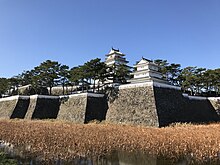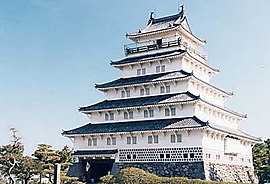| Shimabara Domain (1618–1871)島原藩 Hinoe Domain (1600–1618)日野江藩 | |
|---|---|
| Domain of Japan | |
| 1600–1614 1614–1871 | |
Mon of the
Matsudaira clan
| |
 Far distant view of Shimabara Castle | |
| Capital |
Hinoe Castle (1600–1618) Shimabara Castle (1618–1871) |
| • Type | Daimyō |
| Historical era | Edo period |
• Established | 1600 |
• Disestablished | 1871 |
| Today part of | Nagasaki Prefecture |
The Shimabara Domain (島原藩), located in Hizen Province, was a ruling domain that held authority over the surrounding area of Shimabara. Originally known as the Hinoe Domain, its administrative center was initially established at Hinoe Castle in Minamishimabara, Nagasaki Prefecture. However, it was later relocated to Shimabara Castle in Shimabara, Nagasaki Prefecture. The domain was governed by various clans, including the Koriki clan of the Tokugawa clan, the Fudaira clan, and the Fukamizo-Matsudaira clan of Juhachi Matsudaira. Additionally, the director of Nagasaki, who held the position of tenryo, and the Ogura Domain, a fudai, also played significant roles as the chief of the tozama daimyo in Kyushu. [1] [2] [3] [4]


History
Shimabara was under the rule of the Arima clan in the tumultuous Sengoku period. Arima Harunobu, a daimyo who followed the Christian faith, aligned himself with the eastern army during the Battle of Sekigahara, resulting in the loss of his own domain. However, following the Okamoto Daihachi Incident in 1612, he was imprisoned in Tsuru, Kai Province, and ordered to commit seppuku. Despite this, his son Arima Naozumi distanced himself from his father and had a close relationship with the shogunate. Consequently, he inherited his father's estate after the failed incident. In 1614, Naozumi was appointed to the Hyūga Province Prefectural Domain ( Nobeoka Domain) and was subsequently transferred. Subsequently, the territory came under the control of the shogunate for a period of time. However, in 1616, Matsukura Shigemasa took over the domain from the Gojo domain of Yamato Province for 40,000 koku. The Matsukura clan had previously served as vassals of Tustsui Junkei during the Sengoku period. Matsukura Shigemasa, unlike his father Matsukura Shigenobu, who was a respected general, was known for his oppressive policies towards his subjects and harsh treatment of Christians. Additionally, Shimabara Castle was constructed during his reign, and the government office was relocated from Hinoe Castle to Shimabara. Katsuie, who succeeded Shigemasa, implemented even more severe policies than his father and cracked down on Christians. As a testament to Katsuie's brutality, there was a method of execution called " Mino Odori," where individuals who couldn't pay the yearly tax were dressed in a cloak and burned alive. Shimabara was described as a true hell, as the children of those unable to pay the tax were captured and executed. Additionally, the reported collection of 40,000 koku was inflated to 100,000 koku in order to gain favor with the shogunate.
The people's anger towards Katsuie's oppressive policies eventually erupted, leading to the infamous Shimabara Rebellion in 1637, with Shiro Amakusa as the commander-in-chief. The fury of the fief's inhabitants was so intense that some members of Matsukura's army defected to the people's side, rendering Matsukura's forces insufficient to suppress the rebellion. Recognizing the gravity of the situation, the Edo shogunate dispatched a pacification force led by Shigemasa Itakura. However, Shigemasa proved ineffective and perished in battle. Replacing him as the commander-in-chief was Matsudaira Nobutsuna, a renowned roju known for his "chie Izu." Nobutsuna rallied approximately 120,000 feudal lords from Kyushu to besiege Hara Castle with provisions, including the seasoned warrior Tachibana Muneshige. The rebel army was no match for the well-supplied attack, resulting in the rebellion's suppression three months later. The rebels, including Shiro, were mercilessly slaughtered. Conversely, the feudal lord Katsuie Matsukura faced severe scrutiny for his role in inciting the revolt through his oppressive policies. After the rebellion was quelled, he was beheaded, despite being a daimyo. This denial of the honorable punishment of seppuku and his execution by beheading as a common criminal exemplified the shogunate's grave view of Katsuie's crimes.
The Fukuchiyama Domain in Tanba Province was represented by Matsudaira Tadafusa from the Fukamizo-Matsudaira clan, who brought with him a substantial amount of 65,000 koku. The Matsudaira clan had previously governed Shimabara for five generations, but in 1747, Toda Tadamitsu from the Utsunomiya Domain in Shimotsuke Province arrived with an even larger amount of 77,000 koku. As a result, the Matsudaira clan was relocated to Utsunomiya. However, after two generations, Matsudaira clan, who had been transferred to Utsunomiya in 1774, returned with 65,000 koku. Interestingly, The Toda clan also returned to Utsunomiya during this transition. Following these events, the Matsudaira clan continued to rule for eight generations until 1871 when it transformed into Shimabara Prefecture. Eventually, it was incorporated into Nagasaki Prefecture.
List of daimyōs
Name Tenure Courtesy title Court Rank kokudaka  Arima clan, 1600 - 1612 (
fudai daimyo)
Arima clan, 1600 - 1612 (
fudai daimyo)
1 Arima Harunobu (有馬晴信) 1600 – 1612 Shūri-daiyū (修理大夫) Junior 5th Lower Grade (従五位下) 40,000 koku 2 Arima Naozumi(有馬直純) 1612 – 1614 Saiemonfu (左衛門佐) Junior 5th Lower Grade (従五位下) 40,000 koku  tenryō
tenryō
 Matsukura clan, 1616 - 1630 (
fudai daimyo)
Matsukura clan, 1616 - 1630 (
fudai daimyo)
1 Matsukura Shigemasa (松倉重政) 1616 – 1630 Bungo-no-kami Junior 5th Lower Grade (従五位下) 40,000 koku 2 Matsukura Katsuie (松倉勝家) 1630 – 1638 Nagato-no-kami Junior 5th Lower Grade (従五位下) 40,000 koku  Kōriki clan, 1638 - 1668 (
fudai daimyo)
Kōriki clan, 1638 - 1668 (
fudai daimyo)
1 Kōriki Tadafusa (高力忠房) 1638 – 1655 Sakontaiyu (左近大夫) Junior 5th Lower Grade (従五位下) 40,000 koku 2 Kōriki Takanaga (高力高長) (隆長) 1655 – 1668 Sakontaiyu (左近大夫) Junior 5th Lower Grade (従五位下) 40,000 koku  Matsudaira (Fukōzu) clan clan, 1668 - 1749 (
fudai daimyo)
Matsudaira (Fukōzu) clan clan, 1668 - 1749 (
fudai daimyo)
1 Matsudaira Tadafusa (松平忠房) 1669 – 1698 Tonomori-no-tsukasa (主殿頭) Junior 4th, Lower Grade (従四位下) 65,000 koku 2 Matsudaira Tadakatsu (松平忠雄) 1698 – 1735 Tonomori-no-tsukasa (主殿頭) Junior 4th, Lower Grade (従四位下) 65,000 koku 3 Matsudaira Tadami (松平忠俔) 1735 – 1738 Tonomori-no-tsukasa (主殿頭) Junior 5th Lower Grade (従五位下) 65,000 koku 4 Matsudaira Tadatoki (松平忠刻) 1738 – 1749 Tonomori-no-tsukasa (主殿頭) Junior 4th, Lower Grade (従四位下) 65,000 koku 5 Matsudaira Tadamasa (松平忠祗) 1749 Tonomori-no-tsukasa (主殿頭) Junior 4th, Lower Grade (従四位下) 65,000 koku  Toda clan, 1749 - 1774 (
fudai daimyo)
Toda clan, 1749 - 1774 (
fudai daimyo)
1 Toda Tadamitsu (戸田忠盈) 1749 – 1774 Hyuga-no-kami Junior 5th Lower Grade (従五位下) 77,000 koku 2 Toda Tadatō (戸田忠寛) 1754 – 1774 Iki-no-kami Junior 5th Lower Grade (従五位下) 77,000 koku  Matsudaira (Fukōzu) clan clan, 1774 - 1871 (
fudai daimyo)
Matsudaira (Fukōzu) clan clan, 1774 - 1871 (
fudai daimyo)
1 Matsudaira Tadahiro (松平忠恕) 1774 – 1792 Yamato-no-kami Junior 5th Lower Grade (従五位下) 65,000 koku 2 Matsudaira Tadayori (松平忠馮0 1792 – 1819 Tonomori-no-tsukasa (主殿頭) Junior 5th Lower Grade (従五位下) 65,000 koku 3 Matsudaira Tadayoshi (松平忠侯) 1819 – 1840 Tonomori-no-tsukasa (主殿頭) Junior 5th Lower Grade (従五位下) 65,000 koku 4 Matsudaira Tadanari (松平忠誠) 1840 – 1847 Tonomori-no-tsukasa (主殿頭) Junior 5th Lower Grade (従五位下) 65,000 koku 5 Matsudaira Tadakiyo (松平忠精) 1847 – 1859 Tonomori-no-tsukasa (主殿頭) Junior 5th Lower Grade (従五位下) 65,000 koku 6 Matsudaira Tadaatsu (松平忠淳) 1859 – 1860 Tonomori-no-tsukasa (主殿頭) Junior 5th Lower Grade (従五位下) 65,000 koku 7 Matsudaira Tadachika (松平忠愛) 1860 – 1862 Tonomori-no-tsukasa (主殿頭) Junior 5th Lower Grade (従五位下) 65,000 koku 8 Matsudaira Tadakazu (松平忠和) 1862 – 1871 Tonomori-no-tsukasa (主殿頭) Junior 5th Lower Grade (従五位下) 65,000 koku
Simplified genealogy (Matsudaira-Fukōzu)
- Matsudaira Nobumitsu, 3rd head of the Matsudaira (c.
c. 1400 –
c. 1488–89)
- Chikatada, 4th head of the Matsudaira (c. 1431–1531)
- Nagachika, 5th head of the Matsudaira (1473–1544)
- Nobutada, 6th head of the Matsudaira (1490–1531)
- Kiyoyasu, 7th head of the Matsudaira (1511–1536)
- Usui-hime, m. Sakai Tadatsugu (1527–1596)
- Ogasawara Nobuyuki, 1st daimyō of Koga (1570–1614)
- daughter, (m.?) Mizuno Tadasada
- daughter, m. Tsuchiya Kazunao, 1st daimyō of Tsuchiura (1608–1679)
- Tsuchiya Masanao, 2nd daimyō of Tsuchiura (1641–1722)
- Tsuchiya Nobunao, 3rd daimyō of Tsuchiura (1696–1734)
- daughter, m.
 IV. Matsudaira Tadatoki, 4th daimyō of Shimabara (1st creation) (1716–1749; r. 1738–1749).
IV. Matsudaira Tadatoki, 4th daimyō of Shimabara (1st creation) (1716–1749; r. 1738–1749).
-
 V. Tadamasa, 5th daimyō of Shimabara (1st creation) (
c. 1737–38 – 1801; r. 1749)
V. Tadamasa, 5th daimyō of Shimabara (1st creation) (
c. 1737–38 – 1801; r. 1749) -
 I. Tadahiro, 1st daimyō of Shimabara (2nd creation, cr. 1774) (
c. 1740–42 – 1792; r. 1774–1792)
I. Tadahiro, 1st daimyō of Shimabara (2nd creation, cr. 1774) (
c. 1740–42 – 1792; r. 1774–1792)
-
- daughter, m.
- Tsuchiya Nobunao, 3rd daimyō of Tsuchiura (1696–1734)
- Tsuchiya Masanao, 2nd daimyō of Tsuchiura (1641–1722)
- daughter, m. Tsuchiya Kazunao, 1st daimyō of Tsuchiura (1608–1679)
- daughter, (m.?) Mizuno Tadasada
- Ogasawara Nobuyuki, 1st daimyō of Koga (1570–1614)
- Hirotada, 8th head of the Matsudaira (1526–1549)
-
 Tokugawa Ieyasu, 1st Tokugawa shōgun (1543–1616; r. 1603–1605)
Tokugawa Ieyasu, 1st Tokugawa shōgun (1543–1616; r. 1603–1605)
- Matsudaira Nobuyasu (1559–1579)
- Kuma-hime (1577–1626), m. Honda Tadamasa, 2nd daimyō of Kuwana (1575–1631)
- Kuni-hime (1595–1649), m. Arima Naozumi, daimyō of Shimabara (1586–1641)
- daughter, m. Akimoto Tomitomo, 1st daimyō of Yamura (1610–1657)
- daughter, m. Toda Takamasa, 1st daimyō of Sakura (1632–1699)
- daughter, m. Akimoto Tomitomo, 1st daimyō of Yamura (1610–1657)
- Kuni-hime (1595–1649), m. Arima Naozumi, daimyō of Shimabara (1586–1641)
- Kuma-hime (1577–1626), m. Honda Tadamasa, 2nd daimyō of Kuwana (1575–1631)
- Kame-hime (1560–1625), m. Okudaira Nobumasa, 1st daimyō of Kanō (1555–1615)
- Matsudaira Tadaaki, 1st daimyō of Himeji (1583–1644)
- Eshō-in, m. Nabeshima Tadanao (1613–1635)
- Nabeshima Mitsushige, 2nd daimyō of Saga (1632–1700)
- Eshō-in, m. Nabeshima Tadanao (1613–1635)
- Matsudaira Tadaaki, 1st daimyō of Himeji (1583–1644)
- Tokugawa Yorifusa, 1st daimyō of Mito (1603–1661)
- Matsudaira Yorishige, 1st daimyō of Takamatsu (1622–1695)
- Yoritoshi (1661–1687)
- Yoritoyo, 3rd daimyō of Takamatsu (1680–1735)
- Tokugawa Munetaka, 4th daimyō of Mito (1705–1730)
- Tokugawa Munemoto, 5th daimyō of Mito (1728–1766)
- Tokugawa Harumori, 6th daimyō of Mito (1751–1805)
- Tokugawa Harutoshi, 7th daimyō of Mito (1773–1816)
- Tokugawa Nariaki, 9th daimyō of Mito (1800–1860)
-
 VIII. Tadakazu, 8th daimyō of Shimabara (2nd creation), 8th family head, 1st Viscount (1851–1917; daimyō: 1862–1869; Governor: 1869–1871; family head: 1862–1917; Viscount: cr. 1884)
VIII. Tadakazu, 8th daimyō of Shimabara (2nd creation), 8th family head, 1st Viscount (1851–1917; daimyō: 1862–1869; Governor: 1869–1871; family head: 1862–1917; Viscount: cr. 1884)
- Tadaii (1870–1909)
- Tadaryō, 9th family head, 2nd Viscount (1903–1934; 9th family head and 2nd Viscount: 1917–1934)
- Tadasada, 10th family head, 3rd Viscount (born 1928; 10th family head: 1934–present; 3rd Viscount: 1934–1947)
- Tadatsugu (b. 1965)
- Tadaoki (b. 1967)
- Tadasada, 10th family head, 3rd Viscount (born 1928; 10th family head: 1934–present; 3rd Viscount: 1934–1947)
- Tadaryō, 9th family head, 2nd Viscount (1903–1934; 9th family head and 2nd Viscount: 1917–1934)
- Tadaii (1870–1909)
-
- Tokugawa Nariaki, 9th daimyō of Mito (1800–1860)
- Tokugawa Harutoshi, 7th daimyō of Mito (1773–1816)
- Tokugawa Harumori, 6th daimyō of Mito (1751–1805)
- Tokugawa Munemoto, 5th daimyō of Mito (1728–1766)
- Tokugawa Munetaka, 4th daimyō of Mito (1705–1730)
- Yoritoyo, 3rd daimyō of Takamatsu (1680–1735)
- Yoritoshi (1661–1687)
- Matsudaira Yorishige, 1st daimyō of Takamatsu (1622–1695)
- Matsudaira Nobuyasu (1559–1579)
-
- Usui-hime, m. Sakai Tadatsugu (1527–1596)
- Kiyoyasu, 7th head of the Matsudaira (1511–1536)
- Nobutada, 6th head of the Matsudaira (1490–1531)
- Nagachika, 5th head of the Matsudaira (1473–1544)
- Tadakage (d. 1485)
- Chikatada, 4th head of the Matsudaira (c. 1431–1531)
See also
References
- ^ Hur, Nam-lin (2020-03-23). Death and Social Order in Tokugawa Japan: Buddhism, Anti-Christianity, and the Danka System. BRILL. ISBN 978-1-68417-452-2.
- ^ Shigeo, Nakajima (2003). 大名の日本地図 文藝春秋. Bunshun Shinsho. ISBN 978-4166603527. (In Japanese)
- ^ Mikio, Toyama (1997). 肥前有馬藩「新人民御来社. New People's Onraisha. ISBN 4404025025. (In Japanese)
- ^ Tsunetomo, Yamamoto (2014-05-27). Hagakure: The Secret Wisdom of the Samurai. Tuttle Publishing. ISBN 978-1-4629-1425-8.
- ^ Genealogy (jp)
External links
- "Shimabara" at Edo 300 (in Japanese)
